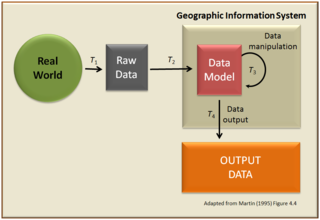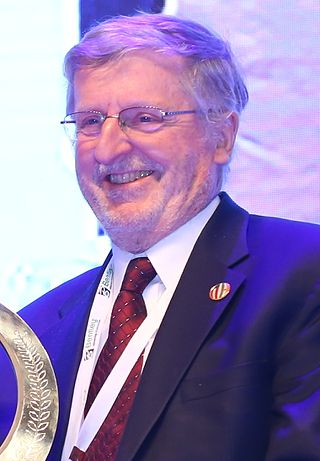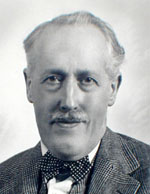Related Research Articles

A geographic information system (GIS) consists of integrated computer hardware and software that store, manage, analyze, edit, output, and visualize geographic data. Much of this often happens within a spatial database, however, this is not essential to meet the definition of a GIS. In a broader sense, one may consider such a system also to include human users and support staff, procedures and workflows, the body of knowledge of relevant concepts and methods, and institutional organizations.

A geographer is a physical scientist, social scientist or humanist whose area of study is geography, the study of Earth's natural environment and human society, including how society and nature interacts. The Greek prefix "geo" means "earth" and the Greek suffix, "graphy", meaning "description", so a geographer is someone who studies the earth. The word "geography" is a Middle French word that is believed to have been first used in 1540.

Waldo Rudolph Tobler was an American-Swiss geographer and cartographer. Tobler is regarded as one of the most influential geographers and cartographers of the late 20th century and early 21st century. Tobler is most well known for his proposed idea that "Everything is related to everything else, but near things are more related than distant things," which has come to be referred to as the "first law of geography." He proposed a second law as well: "The phenomenon external to an area of interest affects what goes on inside."

Michael Frank Goodchild is a British-American geographer. He is an Emeritus Professor of Geography at the University of California, Santa Barbara. After nineteen years at the University of Western Ontario, including three years as chair, he moved to Santa Barbara in 1988, as part of the establishment of the National Center for Geographic Information and Analysis, which he directed for over 20 years. In 2008, he founded the UCSB Center for Spatial Studies.
Geographic information science or geoinformation science is a scientific discipline at the crossroads of computational science, social science, and natural science that studies geographic information, including how it represents phenomena in the real world, how it represents the way humans understand the world, and how it can be captured, organized, and analyzed. It is a sub-field of geography, specifically part of technical geography. It has applications to both physical geography and human geography, although its techniques can be applied to many other fields of study as well as many different industries.

In the context of spatial analysis, geographic information systems, and geographic information science, a field is a property that fills space, and varies over space, such as temperature or density. This use of the term has been adopted from physics and mathematics, due to their similarity to physical fields (vector or scalar) such as the electromagnetic field or gravitational field. Synonymous terms include spatially dependent variable (geostatistics), statistical surface ( thematic mapping), and intensive property (physics and chemistry) and crossbreeding between these disciplines is common. The simplest formal model for a field is the function, which yields a single value given a point in space (i.e., t = f(x, y, z) )
Map algebra is an algebra for manipulating geographic data, primarily fields. Developed by Dr. Dana Tomlin and others in the late 1970s, it is a set of primitive operations in a geographic information system (GIS) which allows one or more raster layers ("maps") of similar dimensions to produce a new raster layer (map) using mathematical or other operations such as addition, subtraction etc.
A feature, in the context of geography and geographic information science, is something that exists at a moderate to global scale at a location in the space and scale of relevance to geography; that is, at or near the surface of Earth. It is an item of geographic information, and may be represented in maps, geographic information systems, remote sensing imagery, statistics, and other forms of geographic discourse. Such representations of features consist of descriptions of their inherent nature, their spatial form and location, and their characteristics or properties.

John Bartholomew, generally known as Ian Bartholomew was a Scottish cartographer and geographer.

Geography is the study of the lands, features, inhabitants, and phenomena of Earth. Geography is an all-encompassing discipline that seeks an understanding of Earth and its human and natural complexities—not merely where objects are, but also how they have changed and come to be. While geography is specific to Earth, many concepts can be applied more broadly to other celestial bodies in the field of planetary science. Geography has been called "a bridge between natural science and social science disciplines."
GIS in environmental contamination is the use of GIS software in mapping out the contaminants in soil and water using the spatial interpolation tools from GIS. Spatial interpolation allows for more efficient approach to remediation and monitoring of soil and water contaminants. Soil and water contamination by metals and other contaminants have become a major environmental problem after the industrialization across many parts of the world. As a result, environmental agencies are placed in charge in remediating, monitoring, and mitigating the soil contamination sites. GIS is used to monitor the sites for metal contaminants in the soil, and based on the GIS analysis, highest risk sites are identified in which majority of the remediation and monitoring takes place.
The National Center for Geographic Information and Analysis (NCGIA) was founded in 1988 and hosted at three member campuses: The University of California, Santa Barbara; the State University of New York at Buffalo; and the University of Maine.
Ian Gordon Simmons is a British geographer. He retired as Professor of Geography from the University of Durham in 2001. He has made significant contributions to environmental history and prehistoric archaeology.
John Terry Coppock CBE FBA FRSE was a British geographer who was the Ogilvie Professor of Human Geography at University of Edinburgh from 1966 to 1986 and Secretary and Treasurer of the Carnegie Trust for the Universities of Scotland from 1986 to 2000. He was a pioneer in three areas of scholarship – agricultural geography, land-use management and computer applications.

Denise Pumain is a French geographer. Pumain specialises in urban and theoretical geography. She is a member of the Austrian Academy of Sciences and of the British Academy.
Concepts and Techniques in Modern Geography, abbreviated CATMOG, is a series of 59 short publications, each focused on an individual method or theory in geography.
Technical geography is the branch of geography that involves using, studying, and creating tools to obtain, analyze, interpret, understand, and communicate spatial information. The other branches, most commonly limited to human geography and physical geography, can usually apply the concepts and techniques of technical geography. However, the methods and theory are distinct, and a technical geographer may be more concerned with the technological and theoretical concepts than the nature of the data. Further, a technical geographer may explore the relationship between the spatial technology and the end users to improve upon the technology and better understand the impact of the technology on human behavior. Thus, the spatial data types a technical geographer employs may vary widely, including human and physical geography topics, with the common thread being the techniques and philosophies employed. To accomplish this, technical geographers often create their own software or scripts, which can then be applied more broadly by others. They may also explore applying techniques developed for one application to another unrelated topic, such as applying Kriging, originally developed for mining, to disciplines as diverse as real-estate prices. In teaching technical geography, instructors often need to fall back on examples from human and physical geography to explain the theoretical concepts. While technical geography mostly works with quantitative data, the techniques and technology can be applied to qualitative geography, differentiating it from quantitative geography. Within the branch of technical geography are the major and overlapping subbranches of geographic information science, geomatics, and geoinformatics.
Arthur Getis was an American geographer known for his significant contributions to spatial statistics and geographic information science (GIScience). With a career spanning over four decades, Getis authored more than one hundred peer-reviewed papers and book chapters, greatly influencing GIScience and geography as a whole. The Getis-Ord family of statistics, one of the most commonly used in spatial analysis, is based on his and J. Keith Ord's work and is still widely used in the creation of hot spot maps.
David John Maguire BSc, PhD, PFHEA, FRGS is a British-American academic and IT executive currently serving as the Vice-Chancellor of the University of East Anglia (UEA)]]. Formerly he was the Vice-Chancellor of the Universities of Dundee, Greenwich and Sussex, and a senior executive at Esri Inc, California for 13 years.
Alexander Stewart Fotheringham is a British-American geographer known for his contributions to quantitative geography and geographic information science (GIScience). He holds a Ph.D. in geography from McMaster University and is a Regents professor of computational spatial science in the School of Geographical Sciences and Urban Planning at Arizona State University. He has contributed to the literature surrounding spatial analysis and spatial statistics, particularly in the development of geographically weighted regression (GWR) and multiscale geographically weighted regression (MGWR).
References
- ↑ University of Bristol Alumni
- ↑ Rhind, David (1968). "The terraces of the Tweed Valley".
{{cite journal}}: Cite journal requires|journal=(help) - ↑ http://www.city.ac.uk/vco/davidrhind/ Archived 8 February 2008 at the Wayback Machine City University. Retrieved 13 December 2007
- 1 2 "David Rhind". Archived from the original on 10 October 2007. Retrieved 9 July 2007.
- ↑ Bank of England|About the Bank|People|The Court of Directors
- ↑ BBC NEWS | In Depth | New Year Honours 2000 | DBEs to CBEs